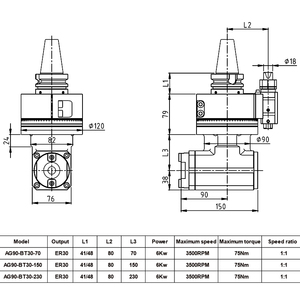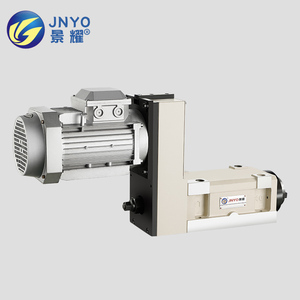
All categories
Featured selections
Trade Assurance
Buyer Central
Help Center
Get the app
Become a supplier

(1011 products available)












A right angle milling head comes in different types based on the design, function, and compatibility with milling machines. Here are some commonly available types of an angle milling attachment:
Some specifications to consider when selecting the suitable right angle head attachment include the attachment's size, taper, and angle. Additionally, attachments with high-speed ratios and precise gear manufacturing typically provide efficient cutting performance.
The attachment's size influences its compatibility with a milling machine. It also determines the space available for cutting workpieces. The taper of the right angle milling machine head is critical because it influences the tool holders used with the attachment. Most right angle head attachments have either CAT or BT tapers.
The attachment's angle allows the milling machine to make beveled cuts and change the workpiece's orientation. The angle of the attachment usually ranges from 30 to 90 degrees. Some attachments may have custom angles to suit specific applications.
It is crucial to maintain the milling machine attachment to keep it working well and ensure the operator's safety. The most essential milling machine right-angle head maintenance task is lubrication. It keeps the gears running smoothly and reduces any noise they make. Lubricate the attachment before and after use, because this will help extend its longevity.
Avoid using lubricants that are incompatible with the grease in the attachment. Regularly inspect the attachment for signs of wear or damage. Look for cracked or worn-out gears, and see if there are any tool holder issues. Fasten loose parts, including bolts, so they don’t come off during use. Thoroughly clean the attachment after each use to get rid of dirt, debris, and old grease. This process makes it easy to spot any issues. Store the angle heads vertically in their original boxes. Use protective covers for unused attachments to keep them from getting damaged.
The high-performance right angle head attachment for a milling machine is used in various industries where the milling process is an essential aspect of production. The attachment is mainly used in the metalworking industry to create grooves, threads, notches, and keyways with high precision. It enables the production of complex-shaped gear teeth with known accuracy.
In the mold-making industry, the right angle milling head makes it easy to create cavities and profiles that are needed when making molds for diverse industries. It also simplifies the process of making lightweight components found in the aerospace and automotive industries right angle milling heads can also efficiently debur and cut these components at various angles and achieve a uniform finish.
This milling attachment offers great versatility, which makes it suitable for many applications such as:
Right angle heads allow the easy machining of angled and tight spaces that are difficult to reach or access using standard milling attachments or heads. They also enable multiple machining operations to be performed on a workpiece without having to change its position, thus improving accuracy and reducing setup time.
Depending on the type of milling head, it can be used with T-slots, dovetails, circulars, and through-hole cut techniques. Some right angle milling heads have an automatic feed selector that allows them to be used in counter-boring, tapping, and through-hole techniques.
Workpiece geometry:
The geometry of the workpiece helps determine the milling head's type and size. Depth and diameter affect the angle head's selection. Longer or deeper workpieces may require long-reach or offset angle heads. Also, ensure the milling head can clamp the workpiece.
Milling head spindle:
An angle milling head spindle connects to the milling machine. The spindle taper must match the machine's spindle. The common spindles used are CT, BT, and BT.
Cutting Tools:
Different angle milling heads use different types of cutting tools, such as end mills, fly cutters, and face mills. When using an angle milling head, ensure that the selected cutting tool fits its holder.
Machine compatibility:
An important factor to consider is whether the angle milling head attaches to the machine. Many angle heads use a straight-shread connector. The thread size must match to achieve proper installation and alignment.
Workpiece material:
Consider the type of material being machined. The angle milling head can cut materials at different speeds. Choose the head that matches the material to be processed. For example, selecting one that is more robust and durable would be ideal if one usually works with hard materials.
Transmission ratio:
The transmission ratio of the angle milling head affects its speed and torque output. Choose the gear ratio that matches the machining requirements.
Q1: Which is better an HSS cutter or a carbide right angle milling cutter?
A1: Right angle milling cutters made of HSS are suitable for general-purpose milling and cost-effective solutions. On the other hand, carbide cutters are preferred for more demanding applications, higher precision, and extended tool life.
Q2: What are the limitations of right-angle milling?
A2: The primary limitation of right-angle milling is the accessibility of workpieces. It is not suitable for machining deep slots or cavities. Also, the cutters used for right-angle milling are typically limited to avoid achieving fine-surface finishes and high-precision tolerances.
Q3: Are right-angle milling heads universal?
A3: No. Universal right-angle milling heads fit different machines. They are interchangeable. It is crucial to confirm the specifications of the milling head and machine to ensure suitability.
Q4: Can a right-angle milling cutter be used with a CNC machine?
A4: Small right-angle milling cutters can be used with CNC machines for various milling applications. However, larger ones are not compatible and should not be used.